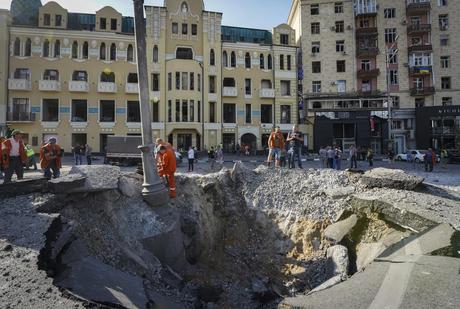
DEVELOPMENT... The story will be updated as new information can be verified. Updated 4 times
SLOVIANSK, Ukraine - Russia and Ukraine traded allegations of rocket and artillery fire at or near Europe's largest nuclear power plant on Sunday, heightening fears that the fighting could cause a massive radioactive leak.
Ukraine's Atomic Energy Agency painted an ominous picture of the threat on Sunday by releasing a map indicating where radiation could spread from the Zaporizhzhia nuclear power plant, which Russian forces have controlled since the start of the war.
Attacks were reported over the weekend not only in Russian-controlled territory adjacent to the plant along the left bank of the Dnieper, but along the Ukrainian-controlled right bank, including the towns of Nikopol and Marhanets, each about 10 kilometers (six miles) from the facility.
Russian Defense Ministry spokesman Igor Konashenkov said on Sunday that Ukrainian forces attacked the plant twice during the day and that shells fell near buildings storing reactor fuel and Radioactive waste.
"One projectile fell in the area of the sixth power unit, and the other five fell in front of the sixth unit pumping station, which provides cooling for this reactor," Konashenkov said, adding that radiation levels were normal. .
The UN's International Atomic Energy Agency also reported on Sunday that radiation levels were normal, that two of the six reactors at the Zaporizhzhia power plant were operating and that, although no full assessment had yet been made, recent fighting had damaged a water pipe, which has since been repaired.
In another apparent attack on Sunday, Russian forces shot down an armed Ukrainian drone targeting one of the Zaporizhzhia plant's spent fuel storage sites, a local official said. Vladimir Rogov, a regional manager based in Russia, said on the Telegram messaging app that the drone crashed into the roof of a building, causing no significant damage or injuring anyone.
Nearby, heavy gunfire overnight left parts of Nikopol without power, said Valentyn Reznichenko, governor of the Dnipropetrovsk region. Rocket fire damaged a dozen residences in Marhanets, according to Yevhen Yevtushenko, the head of the district administration which includes the city of around 45,000 people.
The town of Zaporizhzhia, about 40 kilometers (25 miles) up the Dnieper River from the nuclear power plant, was also targeted by Russian fire, damaging dozens of buildings and homes and injuring two people, the member said. of the city council Anatoliy Kurtev. Russian forces hit a repair shop in Zaporizhzhia for Ukrainian Air Force helicopters, Konashenkov said.
Neither party's claims could be independently verified.
Downstream of the nuclear plant, Ukrainian rockets hit the Kakhovka hydroelectric power plant and the adjacent town three times on Sunday, said Vladimir Leontyev, the head of the local administration based in Russia.
The factory dam is an important route across the river and a potentially key Russian supply route. The dam forms a reservoir that supplies water to the Zaporizhzhia nuclear power plant.
The radiation map released by Ukraine's nuclear agency Energoatom showed that based on the wind forecast for Monday, a nuclear cloud could spread across southern Ukraine and southwestern Russia. The publication of the map may have been intended to warn that if Russian forces were responsible for a radioactive leak, their own country would suffer. During the Chernobyl nuclear power plant accident in 1986, the world's worst atomic energy disaster, radiation spread from Ukraine to several neighboring countries.
Last week, authorities began distributing iodine tablets to residents who live near the Zaporizhzhia plant in the event of radiation exposure. Much of the concern centers on the plant's nuclear reactor cooling systems. The systems require electricity, and the plant was temporarily shut down on Thursday due to what officials said was fire damage to a transmission line. Failure of the cooling system could cause nuclear meltdown.
Periodic shelling has damaged the power plant's infrastructure, Energoatom said on Saturday.
"There are risks of hydrogen leakage and spraying of radioactive substances, and the risk of fire is high," he said.
The IAEA has tried to strike a deal with Ukrainian and Russian authorities to send a team to inspect and secure the plant, but it remains unclear when the visit might take place.
In eastern Ukraine, where Russian and separatist forces are trying to take control, shelling hit the strategically important cities of Kramatorsk and Sloviansk, with no casualties, said Pavlo Kyrylenko, governor of the region of Donetsk. Konashenkov said Russian missile fire killed 250 Ukrainian soldiers and reservists in and around Sloviansk. Ukrainian officials have not commented on this claim, in accordance with their policy of not discussing casualties.
Sloviansk resident Kostiantyn Daineko told The Associated Press he was falling asleep when an explosion ripped through the windows of his apartment.
"I opened my eyes and saw how the window frame was flying above me, the frame and pieces of broken glass," he said.
Russian and separatist forces hold much of the Donetsk region, one of two Russia has recognized as sovereign states.
Ukrainian President Volodymyr Zelensky vowed again on Sunday to retake breakaway areas.
"The invaders have brought degradation and death and they believe they are here forever," Zelenskyy said in his nightly video address on Sunday. "But it's something temporary for them. Ukraine will return. For sure. Life will return.
___
Follow AP's coverage of the war in Ukraine at https://apnews.com/hub/russia-ukraine
___
Andrew Katell contributed to this report from New York.
___
An earlier version of this story has been corrected to show that the Sloviansk resident's first name is Kostiantyn, not Konstiantyn.

